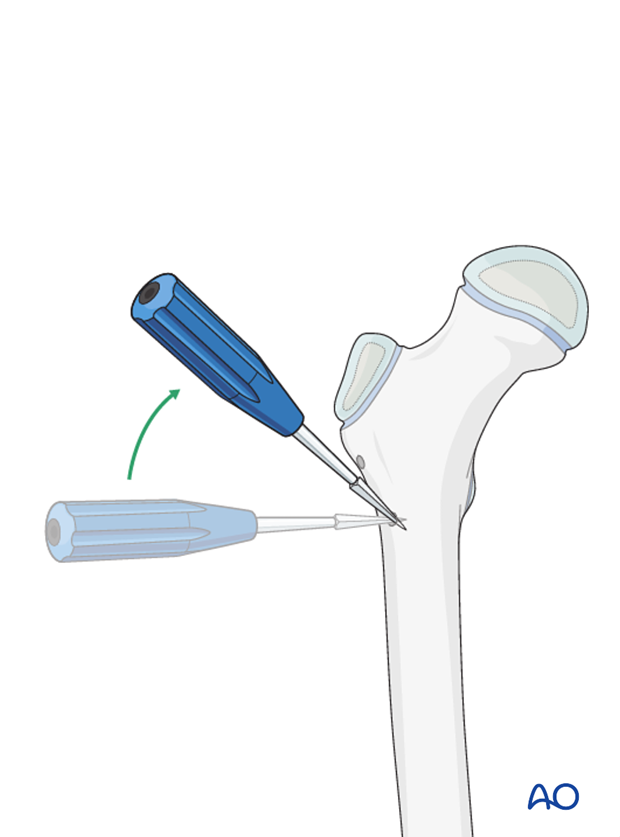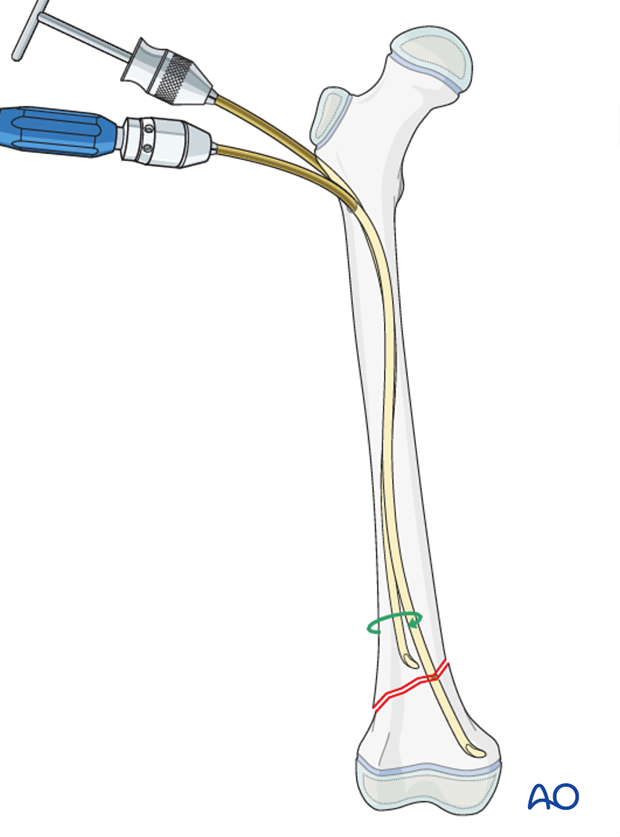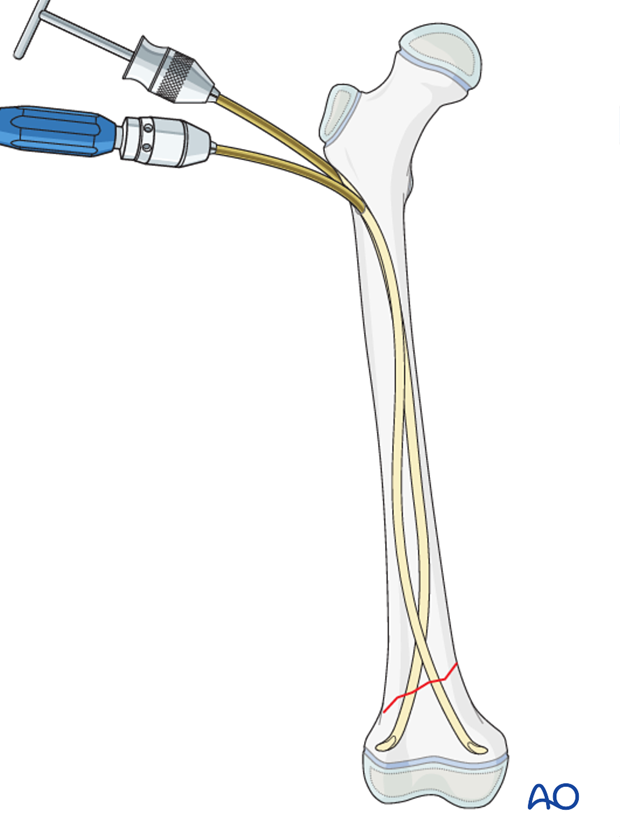ESIN (antegrade)
1. General considerations
The ESIN method involves closed reduction and internal fixation with elastic nails.
It is difficult to treat fractures of the distal metaphysis with retrograde nail insertion as the nail entry sites are likely to propagate into the fracture and the configuration of the nails does not produce sufficient stability.
An antegrade nail construct allows a longer nail length and better stabilization of the distal fragment.

2. Instruments and implants
Instrument set for ESIN
- 2.5–4.0 mm elastic nails
- Awl or drill
- Inserter
- Hammer
- End caps and insertion device
- Impactor
- Extraction plier
- Nail cutter

The end cutter is useful to avoid sharp ends and soft-tissue irritation.

Nail diameter
For optimal stability, the nail diameter should be between 33% and 40% of the narrowest part (isthmus) of the medullary canal.
Both nails need to be of the same diameter.
For later precontouring mark the level of the fracture site on the nail.

3. Patient preparation and approach
Patient positioning
Place the patient in a supine position without traction on a radiolucent fracture table, with a bump under the ipsilateral flank.
When positioning the patient check the rotational alignment of the uninjured femur.

Approach
Expose the bone at the entry points.

4. Opening the canal
Proximal entry point
The proximal entry point is 0.5–1.0 cm distal to the growth plate of the greater trochanter.
Place the awl or drill directly onto the bone and perforate the near cortex, under direct vision, perpendicular to the bone.
Do not hammer the awl to avoid perforation of the far cortex.
When the medullary canal is entered, lower the awl or drill 45° to the shaft axis. Advance it with oscillating movements to produce an oblique canal.

Second entry point
The distal entry point is 2 cm distal and 1 cm anterior to the proximal entry point. This reduces the risk of iatrogenic fractures.
The medullary canal is entered with an identical technique.

5. Nail insertion
Decide whether the crossing point of the nails is to be proximal or distal to the fracture site.
Crossing the nails at the level of the fracture must be avoided.
Precontour both nails in the distal third with the apex at the predetermined level.

Insert the nail through the proximal entry point into the intramedullary canal and advance it towards the fracture site with an oscillating maneuver.

If the tip is stuck in the far cortex and cannot be advanced, remove the nail and bend the tip to give a slightly more pronounced curvature.
Pearl: A short working length (3–5 cm) between the entry point and the inserter improves control of the nail during insertion.

Insert the second nail into the distal entry point and advance it towards the fracture site.

Once it has good contact with the opposite cortex, with the tip having advanced about two-thirds distally in the medullary canal, the contour of the nail is changed to an S-shape with the following maneuver:
- Rotate the nail 180°.
- Bend the proximal portion of the nail, which is outside the bone, in the opposite direction to the previous bend.
- Apply a constant bending force whilst inserting the nail.
This produces an S-shape, which will provide contact with the lateral cortex at the fracture site and with the medial cortex of the proximal third of the femoral shaft.

If this happens reinsert a new nail.

6. Distal fragment advancement
Reduce the fracture and advance both nail tips with an oscillating maneuver past the fracture site into the distal fragment.

If it is difficult to advance either nail while it is positioned against the cortex, rotate the tip towards the center of the bone and advance it across the fracture.

Once the nail has crossed the fracture, redirect the nail tip by reversing the initial direction of rotation.

7. Final seating
Advance the nails and impact them medially and laterally into their respective condylar regions.
Align the nail tips so that they diverge.

If the fracture is very distal, the physis can be perforated with the nails.
A single pass of a smooth nail across a growth plate is unlikely to produce a growth arrest.

8. Cutting the nails
Cut the nails with the dedicated nail cutter.

If this is not available, withdraw the nails far enough to apply the nail cutter, but not beyond the fracture.
Reinsert the nails so at least 1 cm of the nail remains outside the bone.

The ESIN impactor can be used to ensure the optimal length of the nail outside the bone to apply an end cap.

End caps
End caps can be used to increase axial stability.
They will also protect soft tissues.
Insert the end cap over the cut end of the nail and screw it into the metaphysis.

Confirm that the end cap is covering the nail and fixed to the bone with image intensification.

9. Final assessment
Check implant position and fracture reduction with image intensification.
Use clinical examination to check lower extremity alignment.

10. Aftercare
Immediate postoperative care
The patient should get out of bed and begin ambulation with crutches on the first postoperative day.
In most cases the postoperative protocol will be touch-weight bearing for the first 4 weeks.

Analgesia
Routine pain medication is prescribed for 3–5 days postoperatively.
Neurovascular examination
The patient should be examined regularly, to exclude neurovascular compromise.
With displaced high-energy fractures watch for signs of delayed vascular problems.
Compartment syndrome, although rare, should be considered in the presence of severe swelling, increasing pain, and changes to neurovascular signs.
Discharge care
Discharge from hospital follows local practice and is usually possible after 1–3 days.
Mobilization
The patient should ambulate with crutches and begin knee range-of-motion exercises.
Follow-up
Clinical and radiological follow-up is usually undertaken every 2–6 weeks until radiographic healing and restoration of function.
Follow-up for growth deformity
All patients with physeal fractures of the distal femur should have clinical and radiological examination 8–12 weeks postoperatively to assess for signs of physeal growth disturbance or resumption of growth.
Examination should be repeated at intervals until resumption of normal growth is documented. This can be seen as a horizontal growth line (Harris line) that is parallel to the entire physis on both AP and lateral views.
A growth line that converges towards the growth plate may be the earliest sign of growth arrest and should prompt investigation/treatment or referral as appropriate.

Clinical assessment of leg length and alignment is recommended at one-year.
Clinical assessment of leg length uses a tape measure from the ASIS to the medial malleolus.

If there is any concern about leg length discrepancy or malalignment, long leg x-rays are recommended.
Leg length is measured from the femoral head to the ankle joint.

Implant removal
If the patient develops symptoms related to the implant, it can be removed once the fracture is completely healed, usually 6–12 months following injury.













